1994 PONTIAC BONNEVILLE trailer
[x] Cancel search: trailerPage 164 of 290

Parking on Hills
You really should not park your vehicle,
with a trailer attached, on a hill.
If
something goes wrong, your rig could
start to move. People can be injured, and
both your vehicle and the trailer can be
damaged.
But if you ever have to park your rig on a
hill, here’s how to do it:
1.
2.
3.
4.
5.
Apply your regular brakes, but don’t
shift into
“P” (Park) yet.
Have someone place chocks under the
trailer wheels.
When the wheel chocks are in place,
release the regular brakes until the chocks absorb the load.
Reapply the regular brakes. Then
apply your parking brake, and then shift to
“F”’ (Park).
Release the regular brakes.
When You Are Ready to Leave After
Parking
on a Hill
1.
2.
3.
4.
Apply your regular brakes and hold
the pedal down while you:
0 Start your engine;
Shift into a gear; and
0 Release the parking brake.
Let up on the brake pedal.
Drive slowly until the trailer is clear
of the chocks.
Stop and have someone pick up and
store the chocks.
Maintenance When Trailer Towing
Your vehicle will need service more often
when you’re pulling a trailer.
See the
Maintenance Schedule for more
on this.
Things that are especially important in
trailer operation are automatic transaxle
fluid (don’t overfill), engine oil, belt(s),
cooling system, and brake adjustment,
Each
of these is covered in this manual,
and the Index will help you find them
quickly. If you’re trailering, it’s a good
idea to review these sections before. you
start your trip.
Check periodically to
see that all hitch
nuts and bolts are tight.
,j.;
i .a
1. i
,
.?.
163...
ProCarManuals.com
Page 178 of 290
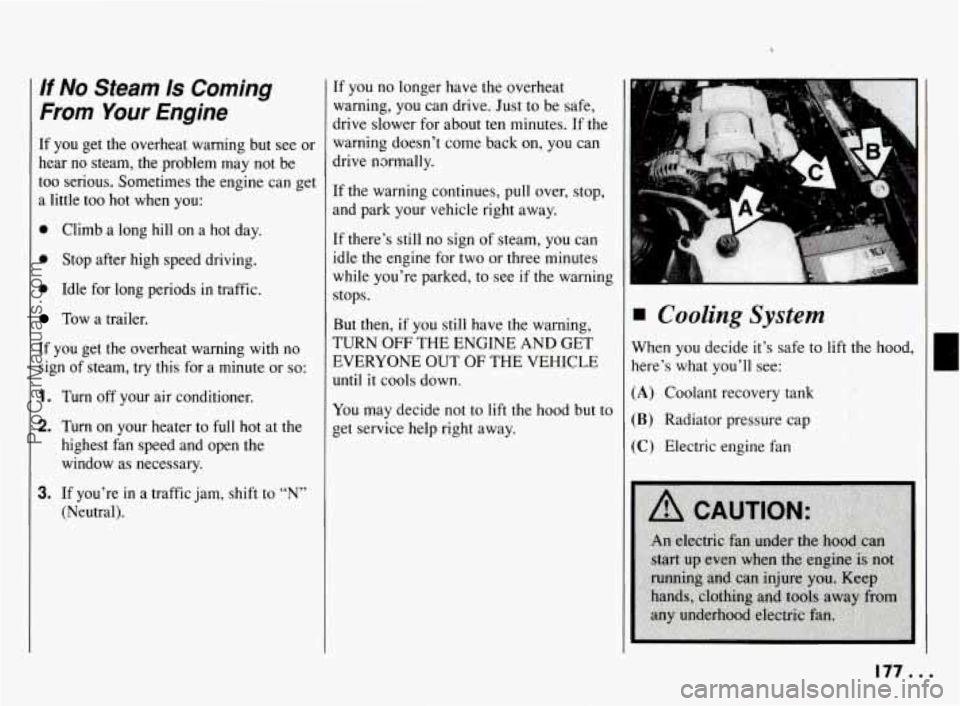
If No Steam Is Coming
From Your Engine
If you get the overheat warning but see or
hear no steam, the problem may not be
too serious. Sometimes the engine can get
a little too hot when you:
0 Climb a long hill on a hot day.
0 Stop after high speed driving.
0 Idle for long periods in traffic.
Tow a trailer.
If you get the overheat warning with
no
sign of steam, try this for a minute or so:
1. Turn off your air conditioner.
2. Turn on your heater to full hot at the
highest fan speed and open the
window as necessary.
3. If you’re in a traffic jam, shift to “N”
(Neutral).
If you no longer have the overheat
warning, you can drive. Just to be safe,
drive slower for about ten minutes. If the
warning doesn’t come back on, you can
drive normally.
If the warning continues, pull over, stop,
and park your vehicle right away.
If there’s still no sign of steam, you can
idle the engine for two or three minutes
while you’re parked, to see
if the warning
stops.
But then,
if you still have the warning,
TURN
OFF THE ENGINE AND GET
EVERYONE OUT
OF THE VEHICLE
until it cools down.
You may decide not to lift the hood but to
get service help right away.
11
Cooling System
When you decide it’s safe to lift the hood,
here’s what you’ll see:
(A) Coolant recovery tank
(B) Radiator pressure cap
(C) Electric engine fan
. 177..
c
ProCarManuals.com
Page 209 of 290
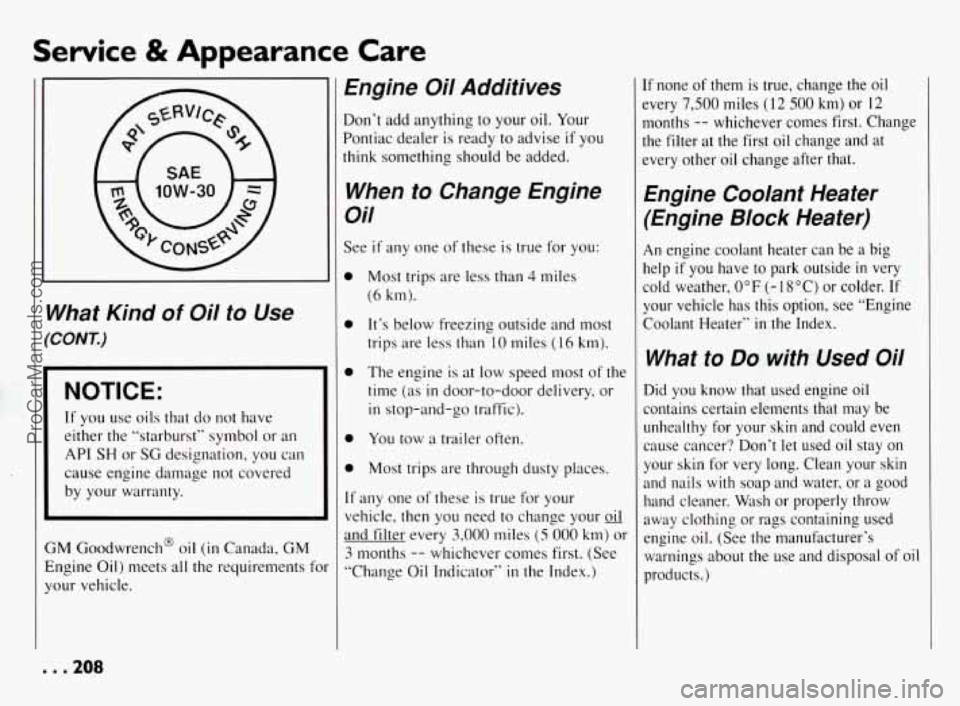
Service & Appearance Care
What Kind of Oil to Use
‘CONT.)
NOTICE:
If you use oils that do not have
either the “starburst” symbol or an
API SH or SG designation, you can
cause engine damage not covered
by
your warranty.
GM Goodwrench@ oil (in Canada, GM
Engine Oil) meets all the requirements fc
your vehicle.
Engine Oil Additives
I Don‘t add anything to your oil. Your
Pontiac dealer is ready
to advise if you
[hink something should be added.
When to Change Engine
Oil
See if any one of these is true for you:
0 Most trips are less than 4 miles
(6 km).
0 It’s below freezing outside and most
trips are less than
10 miles (16 km).
0 The engine is at low speed most of the
time (as
in door-to-door delivery, or
in stop-and-go traffic).
0 You tow a trailer often.
0 Most trips are through dusty places.
If any one of these is true for your
vehicle, then you need
to change your giJ
and filter every 3,000 miles (5 000 km) or
3 months -- whichever comes first. (See
“Change Oil Indicator”
in the Index.)
If none of them is true, change the oil
every
7,500 miles ( 12 500 km) or 12
months -- whichever comes first. Change
the filter at the first oil change and
at
every other oil change after that.
Engine Coolant Heater
(Engine Block Heater)
An engine coolant heater can be a big
help
if you have to park outside in very
cold weather,
0°F (-ISOC) or colder. If
your vehicle has this option, see “Engine
Coolant Heater”
in the Index.
What to Do with Used Oil
Did you know that used engine oil
contains certain elements that may be
unhealthy for your skin and could even
cause cancer‘? Don’t let used oil stay
on
your skin for very long. Clean your skin
and nails
with soap and water, or a good
hand cleaner. Wash or properly throw
away clothing or rags containing used
engine oil. (See the manufacturer’s warnings about the use and disposal of oil
products.)
. . .208
ProCarManuals.com
Page 250 of 290
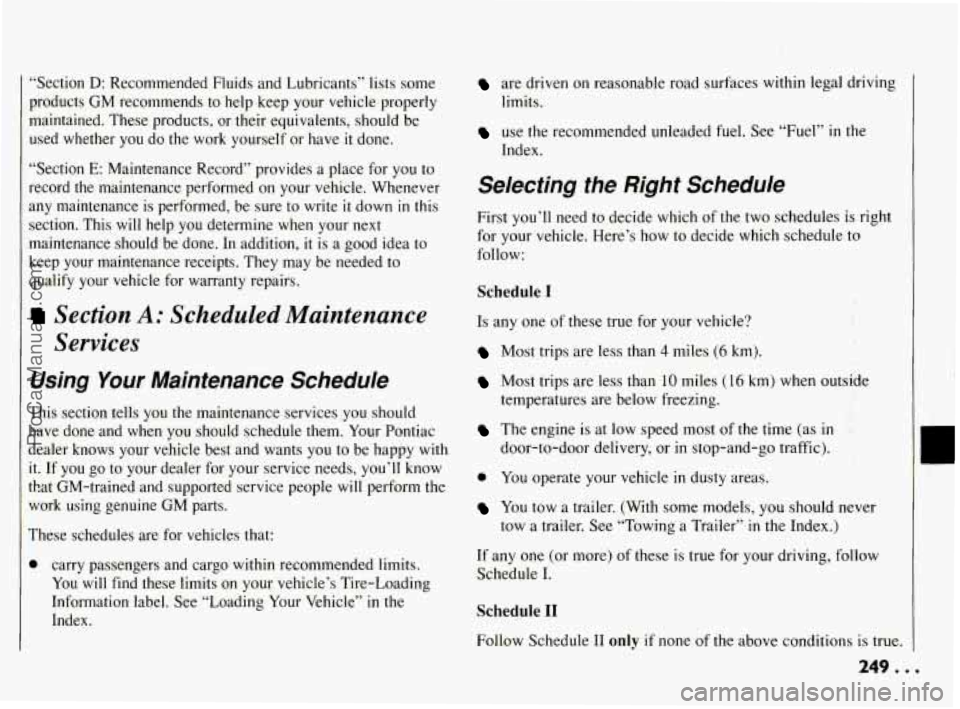
“Section D: Recommended Fluids and Lubricants” lists some
products GM recommends to help keep your vehicle properly
maintained. These products, or their equivalents, should be
used whether you do the work yourself or have
it done.
“Section
E: Maintenance Record” provides a place for you to
record the maintenance performed on your vehicle. Whenever
any maintenance is performed, be sure to write it down in this
section. This
will help you determine when your next
maintenance should be done. In addition, it is a good idea to
keep your maintenance receipts. They may be needed to
qualify your vehicle for warranty repairs.
Section A: Scheduled Maintenance
Using Your Maintenance Schedule
Services
This section tells you the maintenance services you should
have done and
when you should schedule them. Your Pontiac
dealer knows your vehicle best and wants you to be happy with
it. If you go to your dealer for your service needs, you’ll know
that GM-trained and supported service people
will perform the
work using genuine
GM parts.
These schedules are for vehicles that:
@ carry passengers and cargo within recommended limits.
You
will find these limits on your vehicle’s Tire-Loading
Information label. See “Loading Your Vehicle” in the
Index.
are driven on reasonable road surfaces within legal driving
limits.
use the recommended unleaded fuel. See “Fuel” in the
Index.
Selecting the Right Schedule
First you’ll need to decide which of the two schedules is right
for your vehicle. Here’s how to decide which schedule to
follow:
Schedule I
Is any one of these true for your vehicle?
Most trips are less than 4 miles (6 km).
Most trips are less than 10 miles (16 km) when outside
temperatures are below freezing.
The engine is at low speed most of the time (as in
door-to-door delivery, or
in stop-and-go traffic).
”.
0 You operate your vehicle in dusty areas.
You tow a trailer. (With some models, you should never
,.’
tow a trailer. See “Towing a Trailer” in the Index.)
If any one (or more) of these is true for your driving, follow
Schedule I.
Schedule 11
Follow Schedule I1 only if none of the above conditions is true.
ProCarManuals.com
Page 251 of 290
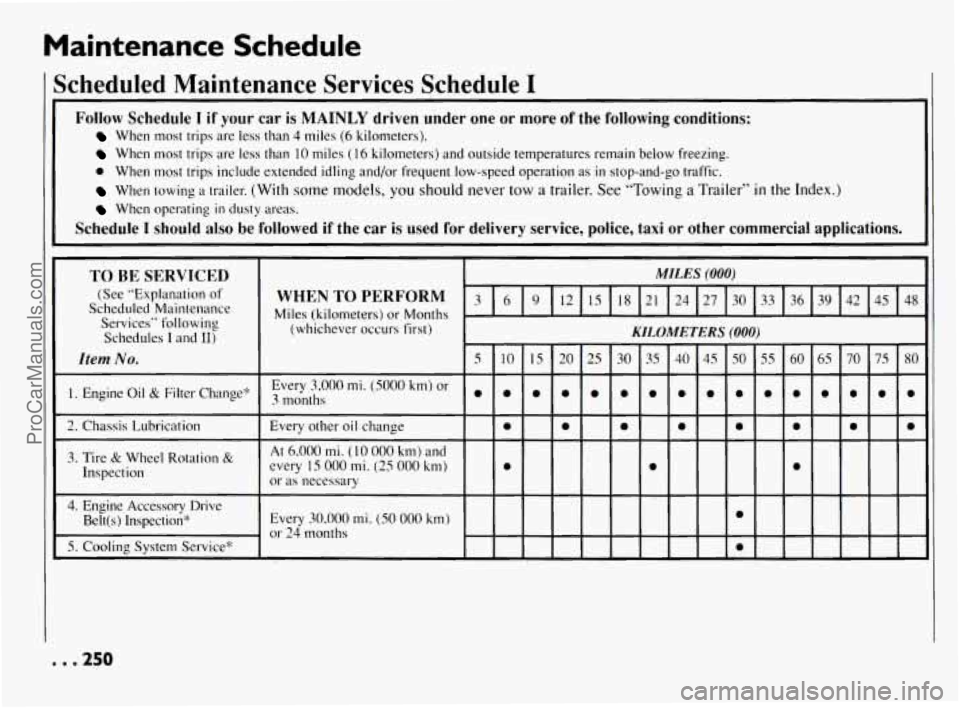
Maintenance Schedule
Scheduled Maintenance Services Schedule I
Follow Schedule I if your car is MAINLY driven under one or more of the following conditions:
When most trips are less than 4 miles (6 kilometers).
When most trips are less than 10 miles (16 kilometers) and outside temperatures remain below freezing.
0 When most trips include extended idling and/or frequent low-speed operation as in stop-and-go traffic.
When towing a trailer. (With some models, you should never tow a trailer. See “Towing a Trailer” in the Index.)
When operating in dusty areas.
Schedule I should also be followed if the car is used for delivery service, police, taxi or other commercial applications.
TO BE SERVICED
(See “Explanation of
Scheduled Maintenance Services” following
Schedules
I and 11)
Item No.
1. Engine Oil & Filter Change”
2. Chassis Lubrication
3. Tire & Wheel Rotation &
Inspection
4. Engine Accessory Drive
Belt(s) Inspection*
5. Cooling System Service* 1
I MILES (000)
(whichever occurs first) I
Every 3,000 mi. (5000 km) or
3 months I I I
Every other oil change I 0
At 6,000 mi. ( 10 000 km) and
every 15
000 mi. (25 000 km) 0
or as necessary
Every
30.000 mi. (50 000 km)
or 24 months
. . .250
ProCarManuals.com
Page 256 of 290
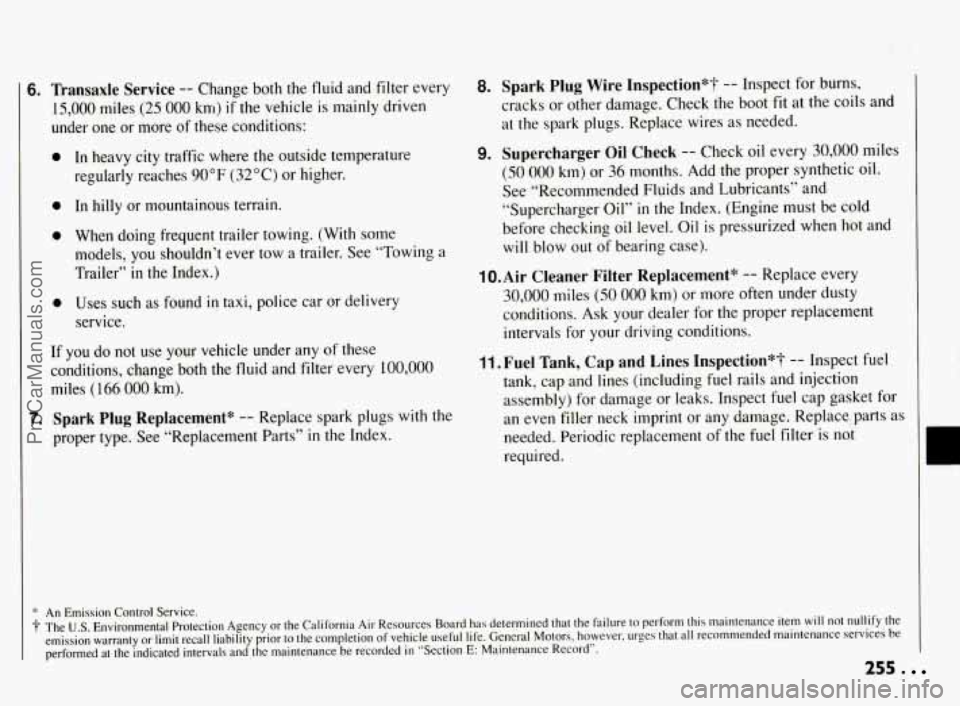
6. Transaxle Service -- Change both the fluid and filter every
15,000 miles (25
000 km) if the vehicle is mainly driven
under one or more of these conditions:
0 In heavy city traffic where the outside temperature
regularly reaches
90°F (32 “C) or higher.
0 In hilly or mountainous terrain.
0 When doing frequent trailer towing. (With some
models, you shouldn’t ever tow a trailer. See “Towing a
Trailer”
in the Index.)
0 Uses such as found in taxi, police car or delivery
service.
If you do not use your vehicle under any of these
conditions, change both the fluid and filter every 100,000
miles (166
000 km).
7. Spark Plug Replacement* -- Replace spark plugs with the
proper type. See “Replacement Parts’’
in the Index.
8. Spark Plug Wire Inspection”? -- Inspect for burns,
cracks or other damage. Check the boot fit at the coils and
at the spark plugs. Replace wires as needed.
9. Supercharger Oil Check -- Check oil every 30,000 miles
(50
000 km) or 36 months. Add the proper synthetic oil.
See “Recommended Fluids and Lubricants’’ and
“Supercharger Oil”
in the Index. (Engine must be cold
before checking oil level. Oil is pressurized when hot and
will blow out of bearing case).
1 O.Air Cleaner Filter Replacement* -- Replace every
30,000 miles (50
000 km) or more often under dusty
conditions. Ask your dealer for the proper replacement
intervals for your driving conditions.
11. Fuel Tank, Cap and Lines Inspection”? -- Inspect fuel
tank, cap and lines (including fuel rails and injection
assembly) for damage or leaks. Inspect fuel cap gasket for
an even filler neck imprint
or any damage. Replace parts as
needed. Periodic replacement of the fuel filter is
not
required.
* An Emission Control Service.
The
U.S. Environmental Protection Agency or the California Air Resources Board has determined that the failure to perform this maintenance item will not nullify the
emission warranty or limit recall liability prior to the completion of vehicle useful life. General Motors, however, urges that all recommended maintenance services be
performed at the indicated intervals and the maintenance be recorded in “Section E: Maintenance Record”.
255 .
ProCarManuals.com
Page 286 of 290
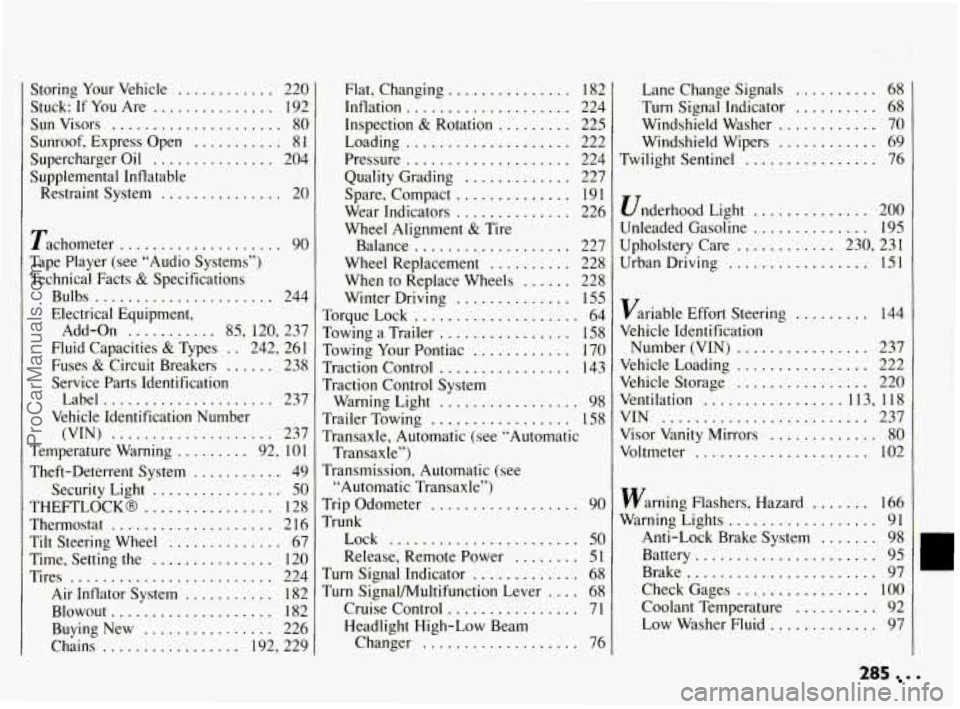
Storing Your Vehicle ............ 220
Stuck:
If You Are ............... 192
Sun Visors
..................... 80
Sunroof. Express Open
........... 81
Supercharger Oil
............... 204
Restraint System
............... 20
Supplemental Inflatable
Tachometer
.................... 90
Tape Player (see “Audio Systems”)
Technical Facts
& Specifications
Bulbs
...................... 244
Electrical Equipment. Add-on
........... 85. 120. 237
Fluid Capacities
& Types . . 242. 261
Fuses
& Circuit Breakers ....... 2.28,
Service Parts Identification Label
..................... 237
Vehicle Identification Number
(VIN) .................... 237
Temperature Warning
......... 92. 101
Theft-Deterrent System ........... 49
Security Light
................ 50
THEFTLOCKB
................ 128
Thermostat
.................... 216
Tilt Steering Wheel
.............. 67
Time. Setting the
............... 120
Tires
......................... 224
Air Inflator System ........... 182
Blowout
.................... 182
Buying New
................ 226
Chains
................. 192. 229 Flat. Changing
............... 182
Inflation
.................... 224
Inspection
& Rotation ......... 225
Loading
.................... 222
Pressure
.................... 224
Quality Grading
............. 227
Spare. Compact
.............. 19 1
Wear Indicators .............. 226
Wheel Alignment
& Tire
Wheel Replacement
.......... 228
When to Replace Wheels
...... 228
Winter Driving
.............. 155
Balance
..................... 227
Torque Lock
.................... 64
Towing a Trailer ................ 158
Towing Your Pontiac
............ 170
Traction Control
................ 143
Traction Control System Warning Light
................. 98
Trailer Towing
................. 158
Transaxle. Automatic (see “Automatic
Transmission. Automatic (see
Transaxle”)
“Automatic Transaxle?’)
Trip Odometer
.................. 90
Trunk
Lock
....................... 50
Release. Remote Power ........ 51
Turn Signal/Multifunction Lever
.... 68
Cruise Control
................ 71
Headlight High-Low Beam
Turn Signal
Indicator
............. 68
Changer
................... 76 Lane Change
Signals
.......... 68
Turn Signal Indicator
.......... 68
Windshield Washer
............ 70
Windshield Wipers
............ 69
Twilight Sentinel ................ 76
Underhood Light
................ 200
Unleaded Gasoline
.............. 195
Upholstery Care
............ 230, 231
Urban Driving
................. 151
Variable Effort Steering
......... 144
Vehicle Identification Number (VIN)
................ 237
Vehicle Loading
................ 222
Vehicle Storage
................ 220
Ventilation 113.
118
VIN ......................... 237
.
.................
Visor Vanity Mirrors ............. 80
Voltmeter
..................... 102
Warning Flashers. Hazard
....... 166
Warning Lights .................. 91
Anti-Lock Brake System ....... 98
Battery
...................... 95
Brake ....................... 97
Check Gages
................ 100
Coolant Temperature
.......... 92
Low Washer Fluid ............. 97
285
ProCarManuals.com